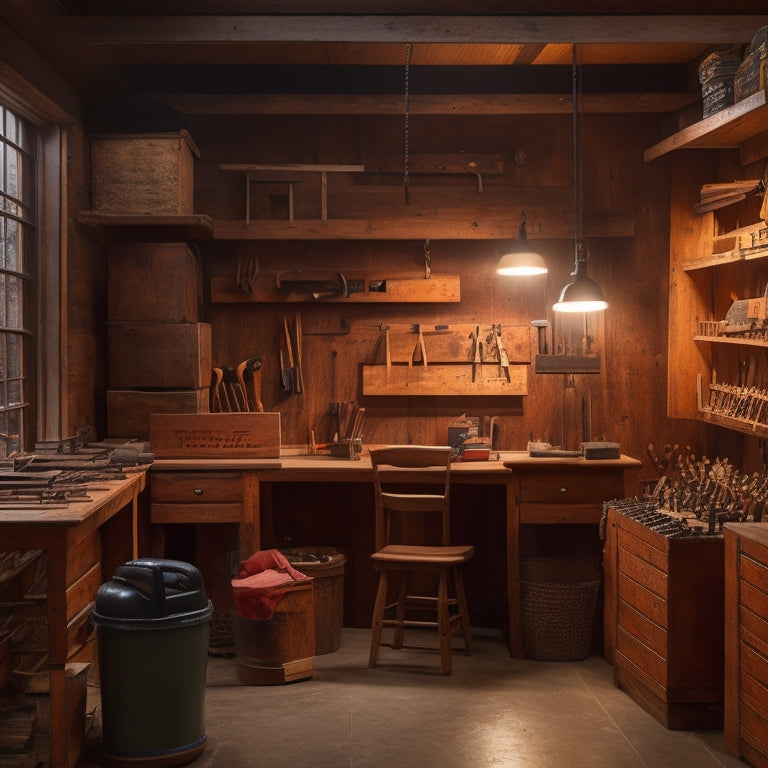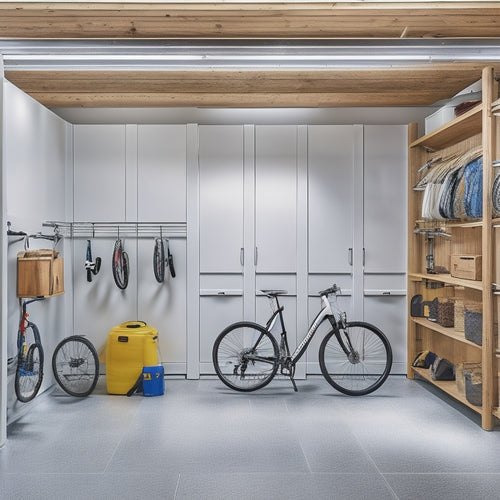
Woodworking Shop Organization Essentials for Beginners
Share
You'll save time, reduce frustration, and improve the quality of your woodworking projects by implementing a well-planned organization system that prioritizes efficiency, ergonomics, and safety in your shop. Start by utilizing essential tools like label makers, pegboards, and drawer dividers to maximize storage capacity and optimize workflow. Create zones for different tasks, label tool stations, and implement a color-coded system to streamline your process. Focus on safety and ergonomics by wearing protective gear, inspecting tools, and designing ergonomic workstations. By prioritizing organization, you'll set yourself up for success and be able to tackle projects with confidence and precision. Now, get ready to take your woodworking skills to the next level.
Key Takeaways
• Utilize a label maker, pegboard, and drawer dividers to organize tools and materials efficiently in the woodworking shop.
• Maximize storage space by going vertical, using mobile solutions, and labeling each storage unit for quick access.
• Divide the shop into zones for cutting, assembly, finishing, maintenance, and storage to enhance productivity and reduce travel time.
• Implement a clear signage system, label tool stations, and use a color-coded organization system to streamline workflow and reduce errors.
• Prioritize safety and ergonomics by wearing protective gear, maintaining a clean and well-lit work area, and designing ergonomic workstations.
Essential Tools for Organization
You'll need a few specialized tools to get your woodworking shop organized, starting with a label maker to identify storage bins and shelves. This will help you quickly locate the materials you need, saving you time and frustration.
Next, invest in a pegboard and accessories, such as hooks and bins, to maximize your wall space and keep frequently used tools within easy reach. A pegboard organization system will keep your tools organized and make it easy to find what you need.
Another essential tool is a set of drawer dividers. These will help you organize your tools and materials within your drawers, making it easy to find what you need and preventing clutter from building up. Look for dividers that are adjustable and customizable to fit your specific needs.
With these tools, you'll be well on your way to a more organized and efficient woodworking shop. By implementing these systems, you'll be able to focus on your projects rather than wasting time searching for misplaced tools or materials.
Maximizing Storage Space Effectively
To maximize storage space effectively, consider the layout of your woodworking shop and identify areas where you can optimize storage capacity. You'll want to make the most of your available space, so think vertically. Install shelves, cabinets, or pegboards to take advantage of ceiling height and keep frequently used items within easy reach. This will help you reclaim valuable floor space for larger equipment or workstations.
Next, look for opportunities to incorporate mobile solutions. Invest in rolling carts, bins, or cabinets that can be easily moved around the shop as needed. This flexibility will allow you to adapt to changing project requirements and reduce clutter.
Consider labeling each storage unit to make sure you can quickly locate specific tools or materials.
Streamlining Workflow With Zones
Divide your woodworking shop into distinct areas to streamline your workflow, reducing travel time and boosting productivity. This approach allows you to group similar tasks and tools together, making it easier to stay focused and efficient. A well-designed workshop layout can greatly impact your overall work experience.
| Area | Purpose | Tools/Equipment |
|---|---|---|
| Cutting Area | Cutting lumber and materials | Table saw, miter saw, circular saw |
| Assembly Area | Assembling projects and components | Workbench, clamps, drill press |
| Finishing Area | Sanding, staining, and finishing projects | Sandpaper, stain, polyurethane, finishing tools |
| Tool Maintenance Area | Cleaning, maintaining, and storing tools | Tool chest, sharpening stones, cleaning supplies |
| Material Storage Area | Storing lumber, materials, and supplies | Shelving units, bins, storage containers |
Labeling and Signage Strategies
As you set up your woodworking shop, you'll quickly realize that a well-designed labeling and signage system is vital for maximizing efficiency and productivity.
You'll want to create a system that helps you quickly identify tools, materials, and workstations, and that's where signage system design comes in.
Signage System Design
You'll need a clear signage system design to ensure that every tool, supply, and workstation in your woodworking shop is easily identifiable and accessible. This is vital for efficient workflow, reduced frustration, and increased productivity. A well-planned signage system design guarantees that you can quickly locate what you need, saving you time and energy.
When designing your signage system, consider the following essential elements:
| Element | Purpose | Tips |
|---|---|---|
| Visual Communication | Convey information quickly and efficiently | Use clear, concise language and icons |
| Shop Layout | Guide users through the shop | Organize signs by workstation or category |
| Branding Elements | Establish your shop's identity | Incorporate your shop's logo, colors, and typography |
| Visual Hierarchy | Direct attention to important information | Use size, color, and placement to create visual priority |
Labeling Tool Stations
With a well-planned signage system design in place, you can now focus on labeling tool stations to further streamline your workflow and maximize efficiency. This pivotal step will help you quickly identify each station and its corresponding tools, ensuring you can access what you need when you need it.
Start by assigning a unique identifier to each station, making it easy to track tools and monitor their usage. This station identification system will also enable you to maintain accurate records of tool maintenance, calibration, and replacement.
When labeling tool stations, consider the type of project you're working on and the materials involved. This will help you organize your tools and materials accordingly, ensuring everything you need is within reach. Effective project organization and material inventory management will save you time and reduce frustration.
Color-Coded Organization
Implement a color-coded organization system to categorize and differentiate your tools, materials, and projects, allowing you to instantly recognize and access what you need.
This system is especially useful for tool organization, as it enables you to quickly identify the location of specific tools. For instance, you can assign a specific color to hand tools, another to power tools, and another to measuring tools. This way, when you need a specific tool, you can quickly scan the area and spot the corresponding color.
Apply the same principle to material storage. You can use different colors to label different types of materials, such as woods, metals, or plastics. This will help you to quickly locate the material you need, saving you time and reducing frustration.
Additionally, you can use color-coding to differentiate between projects, making it easier to keep track of multiple projects simultaneously. By implementing a color-coded organization system, you'll be able to work more efficiently and effectively, allowing you to focus on what matters most – creating high-quality woodworking projects.
Bench and Desk Organization
Bench and Desk Organization
Organizing your workbench and desk is essential to maintaining a clutter-free and efficient woodworking shop. It allows you to quickly locate and access the tools and materials needed for your projects.
To maximize your workspace, focus on strategic tool placement and material storage. When it comes to tool placement, assign a designated spot for each tool and keep frequently used items within easy reach. Consider installing a pegboard or using tool holders to keep your bench surface clear. This will help you stay focused on your project and avoid wasting time searching for misplaced tools.
For material storage, designate a specific area for lumber, sheet goods, and other materials. Use bins, baskets, or shelving units to keep items organized and easily accessible. Label each storage container so you can quickly identify what's inside.
Safety and Ergonomic Considerations
You frequently encounter hazards in a woodworking shop, so it's vital to prioritize safety and ergonomic considerations to minimize the risk of accidents and injuries.
To maintain a safe working environment, implement safety practices such as wearing protective gear, including safety glasses, ear protection, and dust masks. Regularly inspect your tools and equipment to make sure they're in good working condition, and keep your work area clean and well-lit.
Ergonomic workstations are also important in preventing injuries and fatigue. Design your workspace to promote comfortable working postures, with tools and materials within easy reach. Consider investing in adjustable workbenches and stools to accommodate your height and working style.
Proper ergonomics can help reduce the risk of musculoskeletal disorders and enhance your overall productivity. By prioritizing safety and ergonomics, you'll be able to work efficiently and effectively, while minimizing the risk of accidents and injuries.
Frequently Asked Questions
How Do I Maintain Organization After the Initial Setup?
To maintain organization, you'll set aside time daily to put away tools and materials, utilizing storage solutions and labeling systems. Prioritize tasks, optimize your workflow, and allocate time for maintenance to guarantee your space remains organized and efficient.
Can I Organize My Shop in a Small, Rented Space?
You can effectively organize your shop in a small, rented space by maximizing space and utilizing vertical storage solutions, such as wall-mounted cabinets, shelves, and hooks to optimize your layout and keep essential tools within reach.
How Often Should I Clean and Dust My Workshop?
"Dust bunnies multiply like rabbits in your workshop, don't let them! You should dust your tools and workshop at least weekly, and create a cleaning schedule tailored to your usage, ensuring storage solutions stay organized and efficient."
Are There Any Organization Strategies for Left-Handed Woodworkers?
As a left-handed woodworker, you'll benefit from mirroring traditional tool placement to optimize workflow efficiency; try swapping right-handed tool stations and rearranging your workspace to accommodate your natural handedness and movement patterns.
Can I Repurpose Household Items for Workshop Organization?
You'll find a million uses for repurposed household items in your workshop! Get creative with upcycling items like old pallets, crates, or jars to create space-saving hacks and DIY storage solutions that'll transform your workspace.
Related Posts
-

Small Storage Bins to Maximize Shelf Space
When maximizing shelf space, you want to make the most of every inch. Small storage bins are the answer, but choosing...
-

Small Shelving Options for Tight Spaces
You're surrounded by tight spaces in your home, and you need clever shelving solutions that optimize storage without ...
-

Modular Garage Organizers for Clutter-Free Spaces
You're likely wasting precious space in your garage due to inefficient storage and poor organization, but modular gar...


